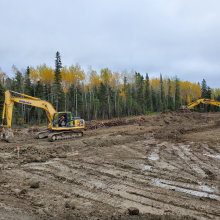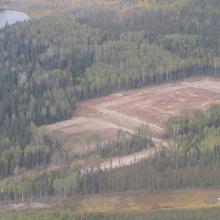Image set

Related services
Related sectors
Related regions
Opening article section
Article section
Rich text
With its environmental challenges and remote location, this large-scale brownfield project was centered on sustainability and delivering meaningful community benefits. Its significant positive impacts and overall excellence were recently recognized by the Canadian Brownfields Network and Actual Media, which honoured Englobe’s Pikangikum project as a finalist in the 2022 Brownie Awards (Remediate category). Congratulations to the project team and everyone in the community!
At Englobe, everything we do is driven by our core values of sustainability, innovation, preserving the natural environment and delivering benefits to local communities. Recently, one team of engineering professionals and specialists embodied these values through their work on a large-scale environmental remediation and earthworks construction project for the Pikangikum First Nation.
Sustainable solutions for a remote community
Located on the shores of Pikangikum Lake in the Kenora District of Northwestern Ontario, this remote Ojibway community is accessible by air year-round, by ice road for a few weeks in the winter, and by boat in the summer. The community was the first of 17 Northern Ontario communities to be connected to the electrical grid, as part of the Wataynikaneyap transmission line project.
As a result of this connection, some obsolete petroleum facilities were dismantled, and 13 areas contaminated by hydrocarbons were identified. Given its accessibility issues, the community sought innovative solutions to avoid the prohibitive cost of transporting this contaminated soil out of the region for treatment.
The community retained Englobe to assess and build the needed infrastructure and conduct soil and water rehabilitation activities. In partnership with the client and project partners, it was decided that building local infrastructure to treat the hydrocarbon-contaminated soil and water would allow the community to take ownership of these environmental liabilities, expand its road network, and build the local capacity needed to treat future contaminants if needed.
Media
Image set

Rich text
Innovation and environmental protection
Soil decontamination and rehabilitation, as well as the treatment of water, were central to this project, which is part of Pikangikum’s overall sustainable development perspective. This approach aligned perfectly with Englobe’s guiding principle of delivering sustainable solutions that add real value to their communities.
“Our team worked to eliminate the contaminated soil problem in and around the community, but also to find a sustainable alternative to transporting contaminated soil outside its borders,” notes Brandon MacKay, Senior Project Manager, Site Remediation at Englobe. “Treating the soil onsite reduces transportation costs for the community and also measurably reduces greenhouse gas emissions generated by this transport.”
To break down the contaminated soils, the Englobe team selected a passive biotreatment technology. Initially collected and stockpiled, these soils are now in the process of being decontaminated. The team further designed and installed a state-of-the-art water treatment unit capable of adjusting treatment based on specific identified contaminants. This unit was used to treat the water from the soil excavation process.
The preservation of local wildlife and the natural environment was a constant concern. The team made sure the work was carried out at a time of year that would not disrupt native birds' nesting season.
As the team prepared the site to build the new three-kilometer access road to the biotreatment facilities, it ensured tree-cutting was kept to a minimum. The few trees cut were then sent to an onsite sawmill to create lumber that the community would store and eventually use in residential or infrastructure construction.
Article quote
Rich text
Benefiting the local community
One of the project’s most important objectives was to maximize social and economic benefits for the Pikangikum community. The Englobe team added 20 members of the Pikangikum Nation to its roster for the entirety of the work. A liaison officer was also hired to ensure smooth communication, maintain good community relations, and facilitate the hiring of the local workforce. Moreover, First Nations and local suppliers were prioritized for the execution of the work, and all project transportation activities by air and water were provided by Indigenous firms.
The project team understood that knowledge transfer was essential to building sustainable local capacity. Thus, the team mentored local operators and day laborers about site rehabilitation activities. These locals gained valuable know-how about the soil and water treatment processes, so that upon project completion, the community could take ownership of any future environmental issues.
“Our team developed a great synergy of mutual assistance with the community throughout the project,” Brandon mentions. “We’re so proud of this project and of the relationships we built with the Pikangikum community. I believe we helped shift local perceptions about consultation and working with private partners and demonstrated that Indigenous-owned and managed projects can be very successful.”